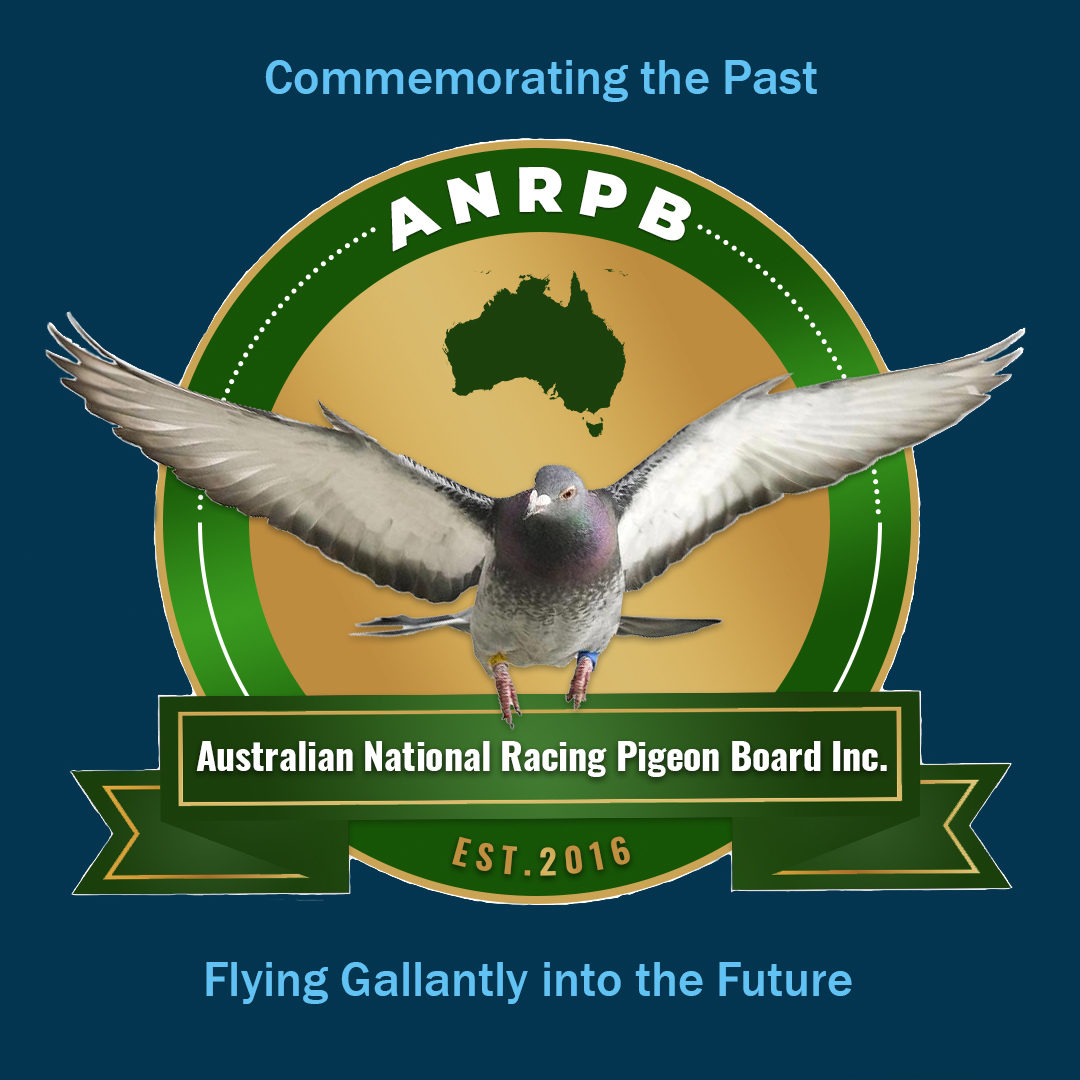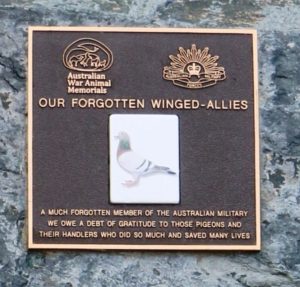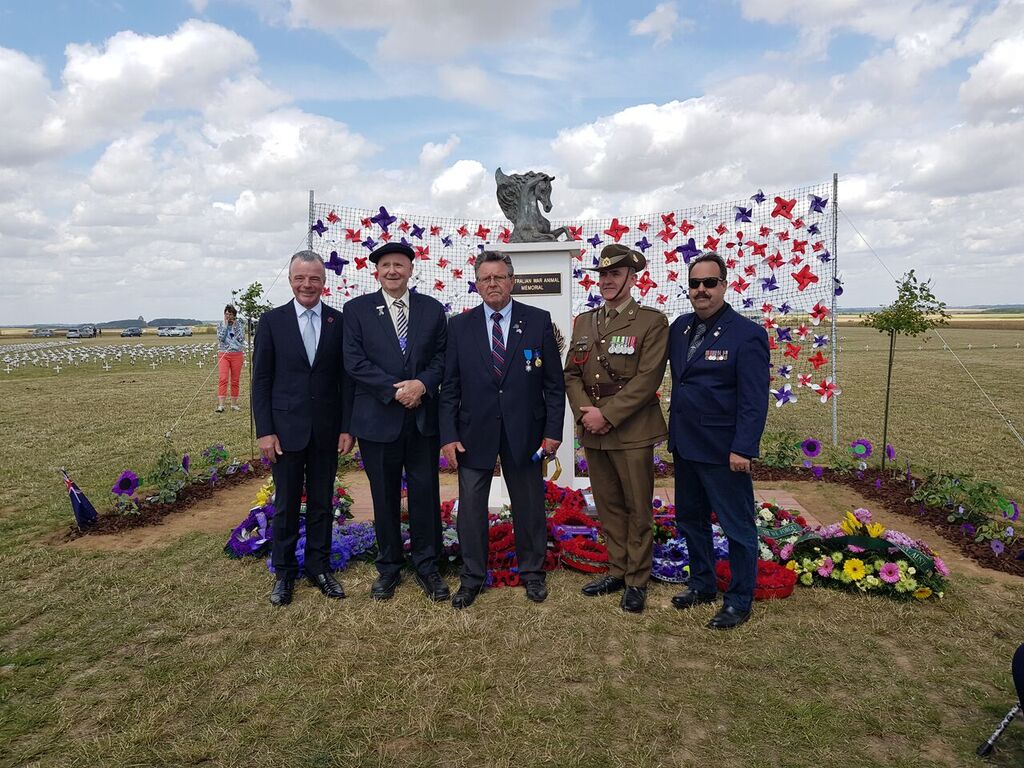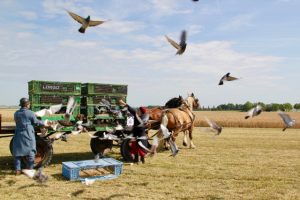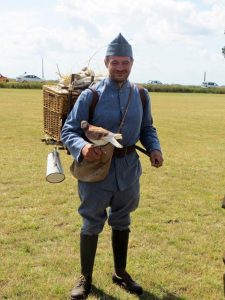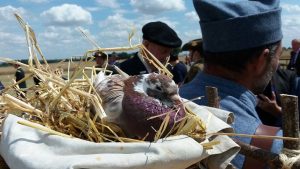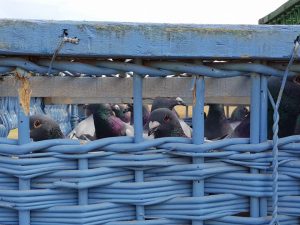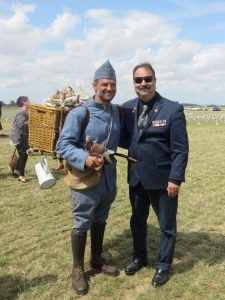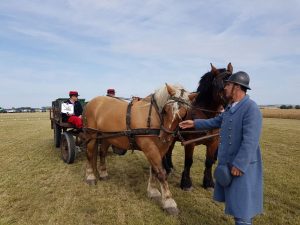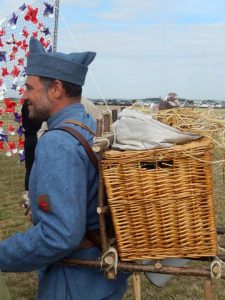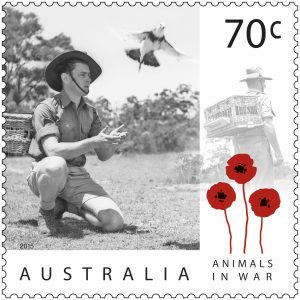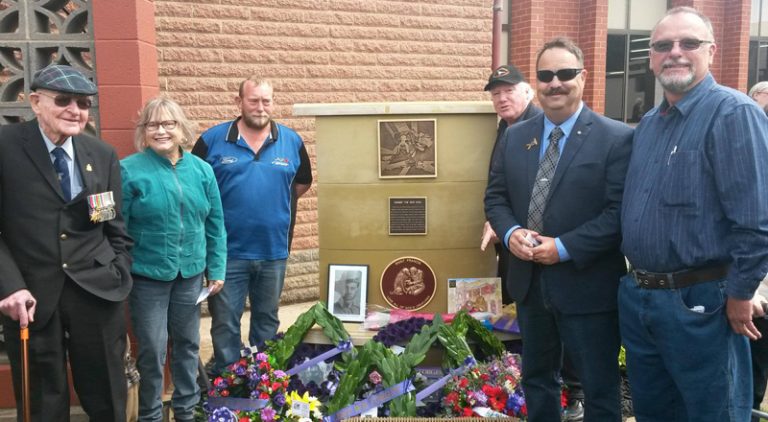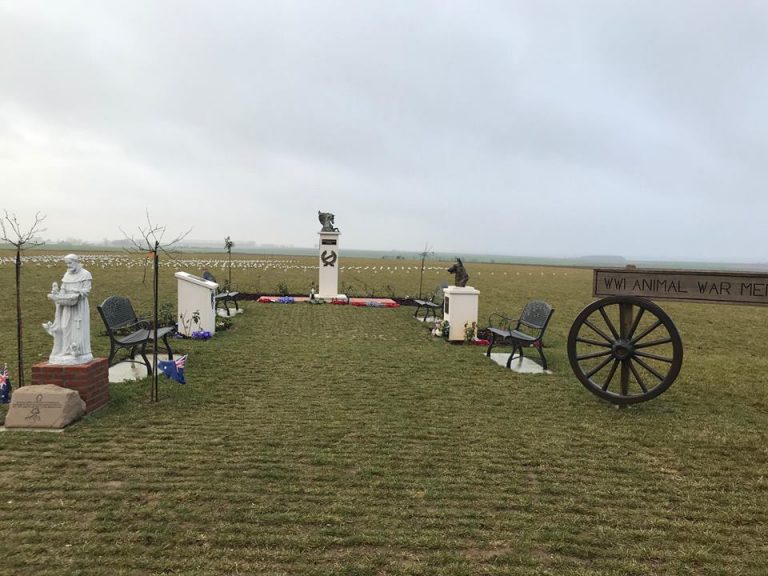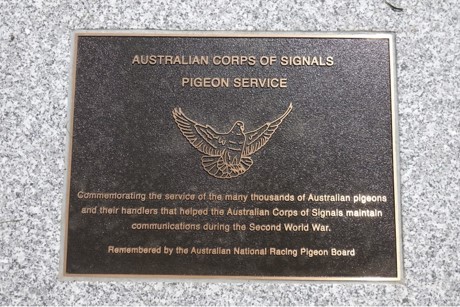 |
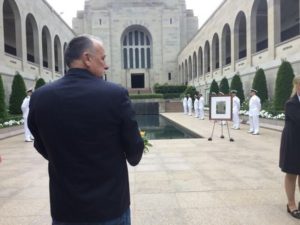 |
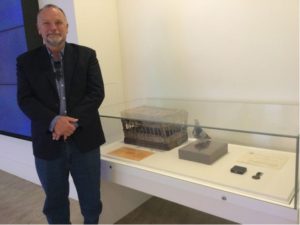 |
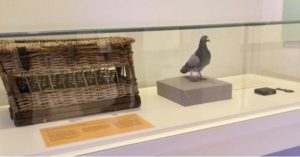 |
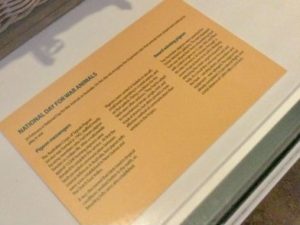 |
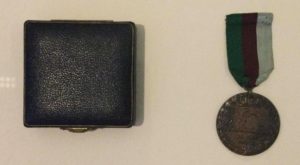 |
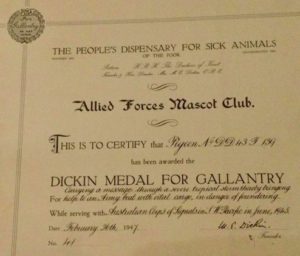 |
The plight of Ukrainian animals 2022 – Aust Animal Aid
Congratulations to the Australian National Racing Pigeon Board
National War Animals Day, Canberra 2020
By Peter D’Arcy
Photos – Bridget MacLeod
On Sunday 23 February 2020, with true Australian War Memorial (AWM) planning, pigeons were released at precisely 3.00pm on the War Memorial Forecourt in front of a large, appreciative crowd. Two members of the Australian National Racing Pigeon Board (ANRPB), Greg Kakoschke and Stephen Shears, were present to release the birds and to be there for the dedication of the ANRPB sponsored plaque commemorating the role of pigeons in war.
The ANRPB initiated negotiations with the Australian War Memorial for this long overdue recognition of the role of pigeons and their handlers in war. The Board, representing all states of Australia, contacted the then Head of the AWM, Dr Brendan Nelson, who offered an invitation to the ANRPB to sponsor a bronze plaque to commemorate the vital role that pigeons played in both WW1 and WW2. In a sense it was only the Board that could have organized the plaque, as it was not something that any State would have felt was their responsibility.
The ANRPB was established in 2015 in response to a Federal Government initiative to set standards and guidelines for the care of all animal livestock and poultry. Hence the ANRPB was required to be in direct contact with appropriate Federal Government Ministries, e.g. Agriculture, and to deal with macro issues in our sport – one result being, the Pigeon Plaque in the grounds of the AWM. Only one result of many!
The AWM has many rules and expectations and it took some persuasion by the Board to appropriately honour both pigeons and their handlers in the wording on the plaque.
It was also agreed that the Plaque would be dedicated on Sunday 23 February 2020, the day before an installation and plaque would be dedicated to the role dogs played in both wars. On that day there were many activities planned to commemorate the roles and to give the visiting public information on the importance of Animals in War.
The Board released 32 pigeons to honour the 32 pigeons that have been awarded the Dickin Medal over both World Wars. The Dickin Medal is the equivalent for animals of the Victoria Cross.
Members welcomed to the AWM
Greg and Stephanie Kakoschke, Stephen and Susan Shears and Paul and Helen Gibbs were welcomed to the Memorial by Curator, Gordon Adler. As guests of the Memorial, they were then invited to a presentation by Nigel Allsopp, one of the presenters speaking at the AWM that day about the Role of Animals in War.
Talk by Nigel Allsopp
Nigel is the President and CEO of the Australian War Animal Memorial Organization. He is an author and expert on war service animals. Nigel has lectured at institutions such as Sandhurst Military Academy in the UK and the New Zealand National Museum. He has written 14 books, including Cry Havoc-the History of War Dogs. Nigel was awarded the Returned and Services League of Australia ANZAC of the Year Award in 2017. This award recognizes the efforts and achievements of Australians who have given service to the community in a positive, selfless and compassionate manner.
Nigel included in his talk the important role of pigeons in war in providing vital communication. He spoke about the role of animals in both World Wars but also pointed out they play a big role in present day wars, and showed photos of mules and donkeys carrying rocket launchers and supplies in Iraq and Afghanistan.
A trick question here -what role did glow worms play in the First World War?
The Board members were then given a tour of the AWM and it was soon obvious to Greg that there was very little on display about pigeons. The only item they saw was a stuffed pigeon – no Dickin Medals (two won by Australian pigeons), no carrying basket from WW2, such as the type donated by Keith Wickham, from South Australia. The AWM also has paintings in its collection of moveable lofts, photos of airmen taking pigeons on board their planes, lists of Australian breeders who donated their best birds to the war effort and maps of where pigeons played a major role in communications in New Guinea. However, they are not on display at present.
Pigeons have been awarded 32 Dickin medals and that’s why 32 pigeons were released on the Sunday. The pigeons were kindly supplied by Anton van der Heever, a member of the Canberra Combine.
Prior to the release, Greg spoke of how Dr Brendan Nelson had agreed to a plaque being dedicated to the role of pigeons, and Greg thanked the present staff of the AWM for their continued support and assistance in the wording of the plaque and making it possible for the plaque to be in place.
Greg spoke of the banner being held by Bob Wrightson, son of Keith Wrightson, who was a pigeon handler in WW2. He thanked Bob and his family for bringing the banner on such an appropriate day. If the banner is donated to the AWM will it be displayed, or stored away as over 90% of donated items are?
Greg thanked Emma McGregor of Arrow Bonze, Victoria, who manufactured the plaque and especially mentioned the efforts of Neil Machar, the Victorian representative of the ANRPB, who played a major role in the overseeing of the making of the plaque.
Greg then introduced Nigel Allsopp who spoke comprehensively of the importance of pigeons in communicating vital information in both Wars and gave examples of the bravery and toughness of individual pigeons. There are people alive today who acknowledge the fact that if not for the reliability of a pigeon in the Second World War, they would not be here. The CEO of a Canberra Institute owes his life to a pigeon his father released following a downed plane, leading to the rescue of the crew. His father lived, came home, got married, and had children!
One can only wonder how many other similar stories pigeon flyers may have. Maybe they could be collected.
On Monday the 24 February, War Animals Day, a plaque and sculpture installation were officially unveiled to honour the role of dogs in war. The role of pigeons was also acknowledged in speeches. Incidentally, dogs have been awarded 34 Dickin medals, and thoroughly deserve recognition for the role they played. In addition to the plaque, there is also a marvellous sculpture of a life-sized dog and its handler in a prominent position at the front of the AWM.
Pigeons deserve a more prominent part at the AWM.
Congratulations to the Australian National Racing Pigeon Board for their initiative, and for the work they have already done. Some examples to date:
-
The incredible work in helping Treidlia BioVet to produce a vaccine against Rota Virus in such a short time.
-
The Board was required by the Federal Government to produce a Code of Practice for Pigeon Racing – how good that experienced pigeon flyers were involved in producing the Code!
-
Ongoing work towards sustaining and growing pigeon racing in Australia.
The Board would like to see a greater presence in the Memorial of pigeons in war and believes the Board may be able to play a vital role in achieving this desired outcome. An annual event focussing on the role of pigeons in war could be promoted on AWM War Animals Day (February 24) commemorating Animals in War.
Board members are volunteers and working hard to promote pigeon racing. Look up their excellent Website at www.anrpb.org , join their email list, and enter your 2020 Race schedule to assist other clubs in planning their race routes and releases.
The ANRPB was honoured to receive an invitation from Dr Brendan Nelson to provide a plaque to commemorate the role of Australian racing pigeons in the theatre of war.
As that invitation was only received last December the ANRPB would like to acknowledge staff here at the AWM who assisted in the development of mutually agreeable wording for the plaque in a highly professional, compassionate and timely manner.
To Anne Bennie, Clare Heffernan, & Amanda Dennett we say thank you for making it possible for the commemorative plaque to be in place for today’s special event.
The ANRPB would also like to express appreciation to Emma McGregor and the team at Arrow Bronze for manufacturing such an outstanding plaque.
Finally, a word of appreciation to Peter D’Arcy of the Canberra Racing Pigeon Combine for his work in planning today’s pigeon release.
I now take great pleasure in inviting Nigel Allsopp, President of the Australian War Animal Memorial Organisation, to share some of his considerable knowledge on the role of Australian racing pigeons with the Australian Army Signals Corps.
Thank you
Greg Kakoschke
President
Australian National Racing Pigeon Board Inc.
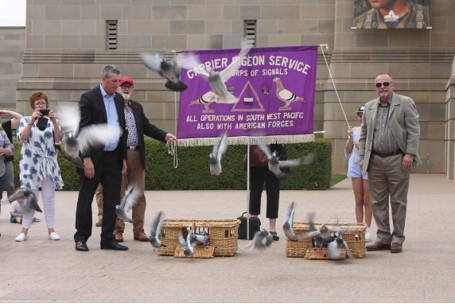
Pigeon banner belonging to Lieutenant Keith Wrightson (dec) son Bob holding banner
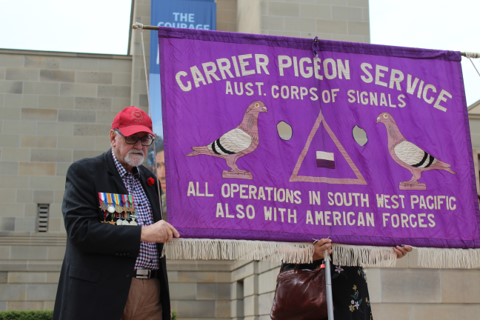
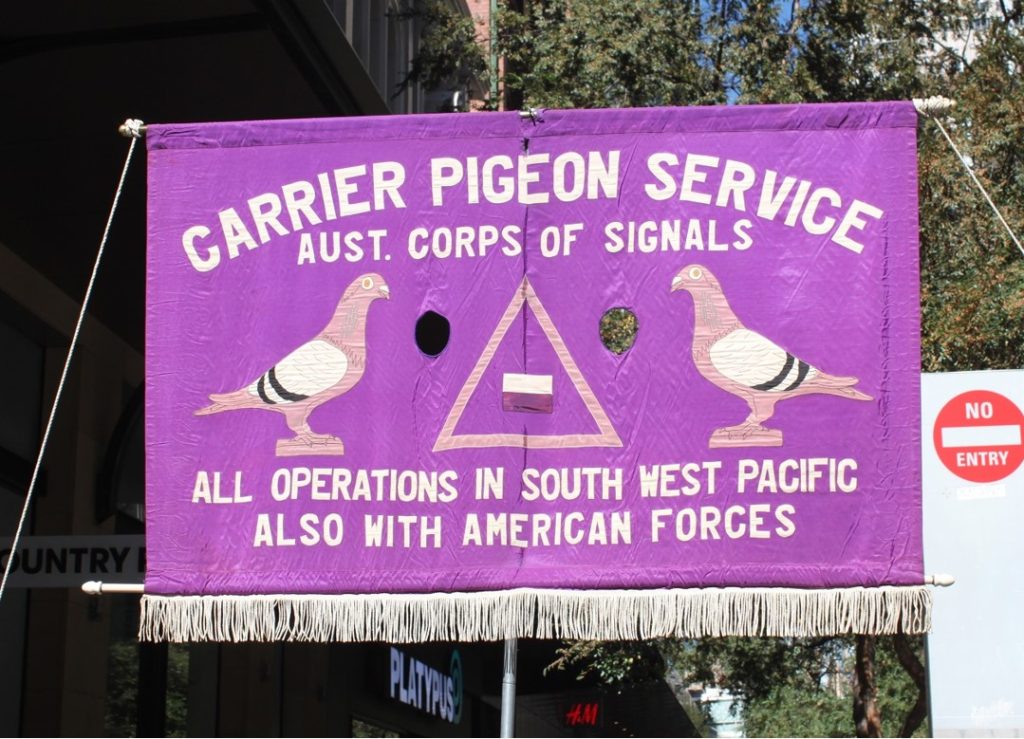
Dickin Medal
The Victoria Cross for animals
The Dickin Medal, instituted by Mrs Maria Dickin, founder of the People’s Dispensary for Sick Animals in England, was popularly referred to as “the animals’ VC”. It was awarded to any animal displaying conspicuous gallantry and devotion to duty associated with, or under the control of, any branch of the Armed Forces or Civil Defence units during World War II and its aftermath.
The Dickin medal– the Victoria Cross for animals– being awarded in 1947 to two Australian pigeons.
AWM 132991
At least two Australian carrier pigeons attached to the Australian Army have received the Dickin Medal:
• Blue bar cock No. 139:D/D:43:T Detachment 10 Pigeon Section (Type B) attached to Detachment 55 Port Craft Company, Madang 12 July 1945. Awarded the Dickin Medal for gallantry carrying a message through a severe tropical storm thereby bringing help to an army boat with a vital cargo, in danger of foundering.
• Blue chequer cock No. 879:D/D: 43: Q Loft No. 5 of 1 Australian Pigeon Section, attached to the US forces, Manus Island, Admiralty Islands 5th April 1944. Awarded the Dickin Medal for gallantry carrying a message through heavy fire thereby bringing relief to a Patrol surrounded and attacked by the enemy without other means of communication.
Corporal G.R. Rayner of No.3 Section (HQ) Carrier Pigeon Unit No.17 Loft, reading a message removed from the container seen on the bird’s leg.
AWM 050781
Short history of the Australian corps of signals pigeon service from 1942
Early in 1942 when Australia was threatened by invasion the communication for the defense of the country was chiefly by line and wireless. However, when the whole of defense system was reviewed certain weaknesses were discovered in the existing facilities. Line was very vulnerable to enemy action, wireless could be overheard by an enemy, and if a landing did take place the use of messengers or liaison officers would not always be practicable. The need for an alternate means of communication was most apparent. This means had to be relatively safe from enemy action, quick, secret and reliable.
To investigate the possibilities of homing pigeons to fulfil this demand, a conference was held between prominent civilian pigeon fanciers and Senior Army Signal officers, the outcome of which was that selected pigeons were to undergo a series of trails. Trials were conducted and proved so satisfactory that the formation of a Pigeon Service was decided upon.
As the Australian Corps of Signals had the responsibility of supplying communications to the Army it was decided to incorporate the Pigeon Service with this Corps, so this new Service was adopted by the Corps of Signals and was known as the Australian Corps of Signals Pigeon Service. The original role for this service was to provide an alternate means of communication between the coast defenses of Australia in the event of invasion or damage to existing means by enemy action.
With this plan in view a number of personnel serving in the Army who had been Pigeon Fanciers in civilian life were selected and formed the trained nucleus of the Pigeon Service and in addition, many civilian Fanciers were enlisted. An appeal was then made to Fanciers throughout Australia to donate pigeons to the Service. The response to this appeal was so overwhelming, both in the quantity and equality of the birds that the Service requirements were completely filled. In all, during 1942-43 a total of 13,500 birds were donated by generous Fanciers, who received no monetary gain from this magnificent effort.
Lofts were organized and by the end of 1942 a complete coverage of the strategic parts of Victoria, New South Wales, Queensland and Western Australia was obtained, linking the various aircraft spotting, coast watching, and volunteer Defence Corps posts. An alternate role was given these lofts in providing communication between Army Small Craft and the coast. This service was so successful that it was soon realized that the use of pigeons in Jungle Warfare had vast possibilities as the use of line and wireless was severely handicapped by the difficult country being encountered.
As the war progressed and the Japanese were pushed back along the Kokoda Trail, 8th Australian Pigeon Section arrived in Port Moresby during Dec 1942. The lofts were located at Paga, Bootless Bay and Milne Bay carrying messages for shore batteries, US Small Ships, and craft of 1st Australian Water Transport Group.
During this time reinforcement birds for the Sections in New Guinea were being flown from Australia, where generous Pigeon Fanciers were donating young birds to the Army. It was found, however, that the sudden change of climate and the humid conditions were very detrimental to these young birds and usually caused an outbreak of roup.
To overcome this difficulty, Army Breeding Lofts were established to breed pigeons in the area in which they were to operate. These lofts were stocked with the pigeons donated in Australia.
The training and maintenance of efficiency of pigeons under tropical conditions presented many difficulties not normally encountered in milder climates.
To overcome these difficulties an officer at Headquarters, Australian Military Forces who had had much experience in the breeding and handling of pigeons, was fully employed in investigating each problem. From the information collated, a system of training and feeding that overcame these obstacles was developed.
The undermentioned points may be recorded as difficulties that arose and were overcome.
- Detachments or complete Sections must be sited by D + 3 if full and successful use is to be made of pigeons used with ground forces and birds must be mobile-trained to enable them to settle quickly.
b. Detachments cannot function satisfactorily without transport; jeeps and trailers for preference should be allotted on the basis of one for each Detachment. Transport is essential to train the pigeons quickly.
c. Young pigeons 3 to 5 months old, preferably bred under tropical conditions, and mobile-trained, proved more tractable than birds approaching 12 months old and over.
d. In the early stages of the New Guinea Campaign it was found that personnel using pigeons had little appreciation of their value and practically no knowledge of their care and handling. This was overcome to a very large extent by attaching lofts to Signal Schools, Infantry Training Schools and Water Transport Schools both on the mainland and overseas. Personnel passing through these schools received instruction and practical demonstrations in the use of pigeons.
e. The retention of one additional loft for each section as a reinforcement and training loft also proved most satisfactory and necessary. This loft made available a reserve of trained pigeons. In addition the extra loft made it possible to train young pigeons without interfering with the routine and commitments of an Operating Detachment.
f. The supply of reinforcement personnel who had not had civil experience with racing pigeons did not prove satisfactory.
g. It was found that to maintain pigeons in the best condition possible it was imperative for lofts to be well ventilated. Ventilation was obtained through a 3″ opening along the top of the back.
h. It was found necessary to withhold all morning exercise flights. Exercise around the loft, if necessary, was carried out in the late afternoon thus minimizing the danger of pigeons “breaking” and endeavouring to find their old location.
i. The maximum “safe” distance which pigeons can be flown under tropical conditions was found to be 60 miles. If the distance is greater than this it is preferable to install an intermediate loft.
j. It was found that coloured pigeons such as pieds, mealys, and red chequers frayed very heavily in the flight feathers so a policy was adopted that only dark feathered pigeons were sent to forward areas.
k. It was found that grain forwarded to the tropics in bags deteriorated rapidly due to weevils and other vermin. Grain that was clean when leaving the mainland soon became infested when lying in Base Store Depots. To counteract this it was decided to forward all grain in airtight drums. This had the desired effect of preventing it from becoming infected from outside sources.
l. Experience has shown that the undermentioned ration scale was quite suitable for pigeons operating under tropical conditions:-
Maple peas 70%
Wheat 10%
Rice Unpolished 5%
Canary Seed (plain) 5%
Linseed (seed) 5%
Milo 2 1/2%
Hulled Oats 2 1/2% - The heat and humidity caused feather lice to be very prevalent and this pest had to be kept in check by frequent dusting of pigeons with a suitable insecticide powder.
Towards the end of hostilities experiments were carried out with DDT for this purpose and a very small percentage of DDT in Talc proved very effective. Pigeons showed no adverse effect or loss of condition through the use of this insecticide even when used in the proportion of 50% DDT and 50% Talc.
As a result of experience gained the Australian Corps of Signals, Pigeon Service was re-organized, early in 1944. Two types of Sections were formed and organized to perform separate roles.
These were: –
A Pigeon Section “Type A” which was designed for use within Field Formations and consisted of:
A Headquarters
One Breeding Loft comprising 100 stock birds (donated by civilian fanciers)
Five Operating Detachments each equipped with one 30-bird loft
A Pigeon Section “Type B” was designed for employment with Small Craft, Line of Communication Areas, and Training establishments and comprised:
A Headquarters
One Breeding Loft of 200 stock birds (donated by civilians)
One Operating Detachment of 120 birds
Four Operating Detachments of 60 birds
The personnel who trained and maintained the birds in each Section consisted of:
1 Officer (Lieutenant)
1 Sergeant
1 Corporal Clerk
6 Corporal Loftmen
6 Signalmen Loftmen (Trade Group 3)
1 Batman Driver
The transport allotted to these Sections varied according to the Section’s operational role, but was fairly standardized at six 1/4-ton Jeeps for mobile work and one 1/4-ton Jeep for static roles.
In addition where three or more Sections operated within a formation a Captain was included on the Chief Signal Officer’s Staff in the capacity of technical adviser on the use of pigeons.
The re-organization of the Pigeon Service on these lines proved highly satisfactory and efficient.
In 1943 due to the increased demands for pigeons in New Guinea, 1st Australian Pigeon Section was moved from Queensland to Port Moresby on 14 July 1943, taking over the territory of 8th Australian Pigeon Section which moved its Headquarters to Buna and operated with small craft along the eastern coast of New Guinea.
In September 1943, 3 lofts and 1 Section were located at Bulldog, Centre Camp and Foxes Saddle to assist in providing communications for Engineers building the Bulldog-Wau Road. The pigeons of these lofts situated in the Owen Stanley Ranges were called upon to operate under conditions which probably no other Army pigeons had to endure. Fortunately the distances they had to cover were not great but at times the birds had to rise 2,000 ft in a distance of 3 miles with torrential rain or mist a distinct possibility. Losses in pigeons were fairly considerable but fortunately rarely was a message not delivered. Pigeons naturally could not operate with normal efficiency under such conditions but they filled a gap caused by the frequent disruption of line communication by the almost incessant rain causing washaways and landslides along the road.
At this time 7th Australian Pigeon Section was located at Darwin and was carrying messages from shore batteries and small craft. In addition valuable work was being carried out by this Section in experimenting with pigeons for mobile warfare.
In December 1943 several lofts were attached to the American 6th Army; the plan being to train American Infantry troops in the handling of pigeons prior to the landings at Saidor, Arawe, and the Admiralty Islands. When landing at these points were made; these lofts manned by Australian personnel with Australian pigeons accompanied the Task Forces and gave complete satisfaction to the American Commanders.
The undermentioned example is typical of the work done by pigeons in these areas.
During the fierce struggle for Manus Island, now an Allied Naval Base; the United States Marines sent a reconnaissance patrol to the strategic village of Drabito to investigate the enemy’s strength and dispositions. The patrol was undetected on its way in but was strongly attacked by 6 Japs whilst returning with the information that about five hundred of the enemy were concentrating in Drabito in preparation for a counter-attack. The patrol’s radio was rendered inoperative during the action so two pigeons were released warning the Headquarters of the impending danger. The Japanese knowing that receipt of this information would interfere with their plans intensified their efforts to wipe out the patrol. These two pigeons were unfortunately shot down immediately they were released leaving Army pigeon 8790 DD 43 Q as the sole remaining means of contact with the Force Headquarters. This pigeon was released during a lull in the fighting and despite heavy fire directed at it on release reached Headquarters thirty miles distance in 47 minutes. As a result of this gallant effort Drabito was heavily bombed causing the enemy to retire thus allowing our patrol to return safely.
The Chief Signal Officer of the American Forces in the South West Pacific Area showed his appreciation in a memo to the Signal Officer in Chief Australian Military Forces in which he stated, “The cooperative action taken by your Office in furnishing pigeon communications for the United States troops during recent operations is greatly appreciated. Reports from the field indicate that the value of pigeons, as an auxiliary means of communication has been established on a firm basis of successful flights performed. The birds, equipment and personnel furnished from Australian sources have proved of the highest value in this respect.”
In Australia a policy was being adopted that reinforcement personnel being sent to New Guinea should receive instruction in the use of pigeons. At Infantry reinforcement centres and at War Transport Training Schools selected reinforcements received instruction on the care and handling of pigeons. In this important work 2nd Australian Pigeon Section and 6th Australian Pigeon Section, which was previously located at Thursday Island, performed a valuable role and as a result of their enthusiasm, the confidence of the fighting soldier in the use of pigeons increased a hundredfold. At these centres these Sections also carried out useful research and experimental work in the care, breeding and handling of pigeons under Army conditions.
During February 1944 the lofts on the Bulldog-Wau Road were withdrawn and a loft was located with New Guinea School of Signals, Koitaki. This loft did sterling work in the training of signal personnel in the handling and care of pigeons.
In May 1944 8th Australian Pigeon Section returned to Australia and was allotted to 7th Australian Division Signals. 1st Australian Pigeon Section which remained in New Guinea took over the commitments of 8 Section. At the same time all lofts were withdrawn from the American Forces and concentrated at Lae, 1st Australian Pigeon Section moving its Headquarters to that area from Moresby. Lofts were allotted to 23 Brigade at Wau and 3rd Australian Division at Bulolo and were used as a means of communication from Wau to Bulolo and for training with Infantry patrols.
In June 1944 lofts were sited at Hansa Bay and Mililat for employment with 5th Australian Division and another was sited at Madang for use with 1st Australian Water Transport Group.
Pigeons by now were in big demand as a means of communication from barges and small craft, many crews refusing to leave without them. The following examples show only too clearly that the confidence of these crews was not misplaced.
During an exceptionally heavy tropical storm in June 1945, Army beat 1402 foundered on Wadau Beach in the Huon Gulf and sent the following cryptic message to its Headquarters at Madang. “Engine failed. Washed on beach at Wadau owing heavy seas. Send help immediately. Craft rapidly filling up with sand”.
Army pigeon 139 DD 43 T, a blue bar cock, carried this message through heavy rain to Madang, a distance of 40 miles in 50 minutes. As a result a rescue ship was sent and the craft, together with its valuable cargo of ammunition and stores, was saved. This pigeon had flown a total of 23 operational flights totaling a distance of 1004 miles.
In March 1945, Water Transport Group Headquarters at Madang received the following message by pigeon – “Steering cable broken am in middle of Rasch Passage. Send help Urgent”.” A rescue craft was sent immediately and reached the stricken barge just in time to prevent it from being washed onto the reef. The saving of this barge, loaded with valuable equipment, was achiev3ed only by the speed the message for assistance was delivered. Army pigeon 1382 QPS 41 a Blue Bar Cock flew the 4 miles to Headquarters in five minutes. This bird had previously done 31 operational flights totaling 1,257 miles.
Lofts of 1st Australian Pigeon Section were attached to the 5th Australian Division which captured Madang in 1944 and pushed on towards Alexishafen and Hansa Bay. The force was so widely scattered and the use of line or Despatch Riders so impractical that the use of a comprehensive Pigeon Despatch Service had to be resorted to supplement wireless. This service covered the whole of the Division’s area of responsibility extending from Saidor in the south to Hansa Bay in the north and as fare inland as the upper reaches of the Sepik River. In a period of about 4 months in mid-1944 the pigeons attached to this Division handled a large amount of traffic, at least six times more quickly than it could have been handled by native carrier or watercraft.
Towards the latter part of 1944 the 10th Australian Pigeon Section arrived in New Guinea and relieved 12 Section of its commitments in that area, 10th Australian Pigeon Section locating its lofts with 3rd Australian Water Transport Group at Port Moresby, Lae, Madang and Jacquinot Bay.
On 1st Australian Pigeon Section being freed of its responsibility in New Guinea it moved to Bougainville in October 1944 for duty with 1st Australian Water Transport Group operating in that area. As operations progressed 60-bird lofts were located at Saposa Island in the North, Gazelle Harbour in the South with a 240-bird loft at Section Headquarters at Puriata Island. This Section was now carrying 800 messages a month, some birds carrying 4 and 5 operational messages a week. In addition to providing a service for small craft pigeons from this Section were used extensively by War Correspondents who found that due to heavy operational traffic on the normal lines of communication and the length of their despatches there was a delay of 48 hrs in transmitting their reports from the battle area to Torokina. Pigeons proved the answer to this bottleneck and it is due to these remarkable birds that news of campaigns in this area was made available to the public 24 hours after an action took place.
On one particular occasion when the battle for Buin Road was at its height a pigeon carried a special press announcement of 2,000 words for a distance of 50 miles in 75 minutes. This despatch had to be carried in a special container as it was much too large to place in the normal carrier. As a result of this exceptionally fine effort the Australian public had the news of the Buin Road success only twenty-four hours after it actually happened. If this pigeon had not carried the message it would have taken several days to deliver this announcement to the Australian wireless terminal as the forward wireless sets were fully occupied in passing operational messages and all roads had been washed out by heavy rains.
The 7th Australian Pigeon Section which had previously been operating at Darwin arrived at Bougainville in October 1944 and lofts were allotted to Brigade and Battalion level.
As the Australian troops advanced, lofts from this Section moved forward with them, pigeons carrying messages from Infantry patrols, personnel of these patrols having the utmost faith in the birds.
During this campaign, in July 1945 a loft was established at Toko on the southern coast of Bougainville. On one occasion an Infantry Company of the 3rd Australian Division was pinned down and surrounded by a superior enemy force. The Japanese had cut off or destroyed all means of communication to Battalion Headquarters except two pigeons carried by the Company. Army pigeon 3863 DD 44 was despatched with an urgent call for reinforcements and artillery support in order that the position could be relieved by nightfall. Despite heavy tropical rain and the fact that this bird was fired on by 60-70 Japanese immediately on release, Army pigeon 3863 DD 44 flew the 22 miles in 3 hours arriving at the loft in an exhausted and wounded state. As a result of this gallant effort artillery support was given and the Company with its wounded was withdrawn safely before dark.
Work such as this was not quite common and the pigeons were definitely established as a means of communication in Jungle Warfare. Demands for pigeons were now so great that it was becoming exceedingly difficult to meet all demands, in some cases pigeons were liberated singly instead of the normal procedure of liberating in pairs.
During November 1944, the 4th Australian Pigeon Section arrived at Aitape from the mainland and moved with Sigs 6th Australian Division down the coast until Wewak was reached.
Lofts worked with Infantry Battalions and Cavalry Commando Squadrons. During February 1945 an important Infantry patrol known as Jock Force had been out of communication with 6th Australian Division for some days when 4 Pigeon Section was ordered to drop pigeons from aircraft to the patrol for the purpose of carrying vital reports back to Division Headquarters. Shortly afterwards six birds were successfully dropped by parachute to the patrol. Despite the fact that these pigeons had only previously been used on the coastal areas over distances up to 10 miles and high features in the Torricelli Mountains had to be negotiated, the first pigeon brought back a message a distance of 45 miles in 50 minutes after being fired on by the enemy on release. From information carried by these birds many successful air strikes were made and future operational moves were planned.
Also in November 1944, the 9th Australian Pigeon Section arrived at New Britain and set up their headquarters with Sigs 2nd Australian Division at Jacquinot Bay. On arrival a 30-bird loft moved with 36th Infantry Battalion to Open Bay where the birds did valuable work with Infantry Patrols. Another loft was attached to 13th Brigade at Tol Plantation. The demand for pigeons in this area was so great that it was necessary to increase the detachment by another 30 birds.
During February 1945 a detachment of 5th Australian Pigeon Section left Brisbane with 22nd Line of Communication Sigs for Morotai. Pigeons travelled well as [illegible original damaged] made for the loft to be erected on the deck of the ship.
[See above] eventually moved with 26th Brigade to Tarakan. Pigeons [see above] without difficulty and were soon proving their worth in operations with a Machine Gun Battalion and Small Ships Company. Monthly traffic handled by this loft was 4,500 groups, distance flown averaging 35 miles.
In April 1945, 3rd Australian Pigeon Section complete moved from Townsville for Labuan with the rear party of 9th Australian Division. Due to lack of space on the ship it was impossible to arrange deck loading for the lofts and the pigeons were therefore confined to the baskets, their condition suffered accordingly and many were badly picked about the eyes and some suffered wing cramp. Detachments were later attached to the Brigades and good results were achieved.
Also in April 1945, the balance of the 5th Australian Pigeon Section left Cairns for Morotai. Deck loading of lofts was arranged and all pigeons were given freedom of lofts whilst in transit. All pigeons arrived in first class condition and resettling of pigeons in Operational Detachments was carried out within 7 days. This Section was located at “A” Australian Corps Sigs, Morotai, and filled an important role as it’s trained young birds were made available to both 3 and 8 Pigeon Sections. In addition the Section controlled all breeding activities, using in addition to its own Breeding Detachment the Breeding Detachments and 3 and 8 Pigeon Sections. A fine type of young bird was bred and given early training prior to its despatch to an Operating Detachment.
During May 1945, the 8th Australian Pigeon Section moved from Townsville with Sigs 7th Australian Division enroute to Balikpapen. Here again it was necessary to confine the birds to the baskets for the whole of the journey which necessitated a period of time being allotted for recuperation.
This Section averaged 7,500 groups per month and the messages carried were all of an operational nature from forward patrols, distances covered by the birds ranged up to 25 miles and an average velocity of 40 mph was maintained.
Very meritorious work was carried out the Detachments of this Section, as an example, a patrol of the 2/9th Infantry Battalion located enemy positions approximately 16 miles from Rikko where an advanced 30-bird Pigeon Detachment was established. Two pigeons were released after being confined 3 days in a 2-bird container and flew the 16 miles in 25 minutes. The information carried was of such a nature that valuable data was obtained as to enemy strengths not previously available.
As a further example of the fine efforts put up by these feathered messengers, 2 birds accompanied a forward patrol of 2/14th Infantry Battalion, the patrol was ambushed and pinned down by a strong party of Japanese causing casualties to our men. The pigeons were despatched with a message calling for air support and blood plasma for the injured. The air strike was successful causing the enemy to abandon its position and arrangements were made for the delivery of the blood plasma. The distance covered was 38 miles and was flown in 40 minutes.
The high standard of efficiency attained by the Australian Corps of Signals Pigeon Service was rendered possible by the technical knowledge and keenness of its Officers and Men.
All Officers and NCO’s had had wide experience in civilian pigeon racing and the practical experience of such Officers as Captain D.H. Day, Captain H.T. Cornish, Lt. S. Cranfield, Lt R. Ware, Lt Richmond, Lt E. Gofton, Lt A. Imber, Lt. L. Roach and Lt K. Wrightson together with the enthusiasm and knowledge of the Ors, made the success of this branch of the Australian Corps of Signals assured.
A contributing factor to the achievements of the Pigeon Service was the outstanding quality of civilian-donated birds, and fanciers can be justly proud of their magnificent contribution to the War effort. Taken from AWM Official Record Series: AWM54, Item 425/15/4
The Australian War Animal Memorial Organisation (AWAMO) is a not for profit charity that raises awareness of the deeds and sacrifices that animals have made in warfare. On the 21st July 2017 AWAMO in cooperation with the people of Pozieres, AWAMO proudly opened the first war animal memorial on the Western Front. This memorial recognised all animals from all Nations that were involved in the Great War. Pozieres was the scene of some of the most bitter and costly fighting for Australian troops in WWI. The battle was also the place of untold losses in animal life. It is estimated that over 9 million serving animals perished or were wounded in the Great War. We should never forget that not only two legged but four legged diggers served this nation and still
continue to do so today. These animals have demonstrated true valour and an enduring partnership with humans and they will now be honoured with this beautiful new memorial and rose.
Recently VIPs and speakers at the opening were Dr Brendan Nelson, Dr Harry Cooper, Pozieres Mayor Bernard Delattre, and Nigel Allsopp President of AWAMO.
The pictures below shows the war animal memorial at Pozieres and release of pigeons.
At the end of the ceremony a spectacular display of 100 pigeons were let loose from a WWI French pigeon service re-enactor team complete with heavy horses.
President of AWAMO Nigel Allsopp with WWI local French army re-enactor with his pigeons.
Pigeons were used all over the South West Pacific area during WWII. Two Australian carrier pigeons attached to the Australian Army even received the Dickin Medal: the animals’ equivalent to the VC was awarded to an Australian bird, whose flight to Madang saved the crew and valuable cargo of a boat that was foundering during a tropical storm. In driving rain the bird had covered 64 kilometers in 50 minutes. By the war’s end it had been on 23 missions. Stamp below featuring Purple Poppies for raising funds for Australian War Animal Memorial Organization.
The other medal went to a pigeon attached to American forces on Manus Island after a group of about 200 men were pinned down by the Japanese in April 1944. Suffering casualties and with gunfire raining down, they managed to release a pigeon carrying a plea for help. The bird arrived back at base 48 kilometers and 47 minutes later. Aircraft were sent to clear the area; the troops were saved.
Another time, a box containing a pair of birds was parachuted into the mountains, so a surrounded patrol could detail its position. Birds brought relief to Army engineers stranded by landslides while building a jeep track deep into the Owen Stanley Range.
The Australian War Memorial says of the service: ‘The pigeons of these lofts were called upon to operate under conditions which probably no other Army pigeons had to endure. At times the birds had to rise 2000 feet in a distance of three miles, with torrential rain or mist a distinct possibility. Rarely was a message not delivered.’
Nigel Allsopp is a well-known author and expert on war and service animals and captive zoo animal management.
He is the founder of Australia’s largest war animal charity which ensures the deeds and sacrifices of four-legged diggers is not forgotten via the establishment of memorials in Australia and internationally.
Nigel is a passionate and much sought after speaker as he’s able to engage listeners with stories and factual experiences from his years of both practical and researched experiences in this field.
His expertise is called upon by the Defence Department and government agencies such as Veterans Affairs, RSL Headquarters and Commonwealth centenary committee.
A published author of 9 books, including an international bestseller- Cry Havoc- the history of war dogs- published in three languages.
Nigel was awarded Australia’s RSL – ANZAC of the Year Award 2017 which recognizes the efforts and achievements of Australian’s who have given service to their fellow Australian’s and to the community in a positive, selfless and compassionate manner. Nigel is a frequent presenter at RSL, Lions and Rotary Clubs and MC.
Many of his stories relayed are emotional and humorous and provoke much debate and questions, making him an ideal speaker and presenter at a wide variety of events.
There is a war animal exhibit opening on the 23rd Feb 2018 at Victoria Barracks Brisbane Qld . Below is the link to the museum by clicking on picture.
https://blhn.org/sites/army-museum-south-queensland/
Other events include the pictures below which was taken at the Croydon / Kilkenny RSL and left to right: is Jack Hicks (Woodville – West Torrens), Sofia Thalbourne (SAHPA Ring Secretary), Perry Burton (Para Hills), David Thalbourne (SAHPA), Nigel Allsopp (Australian Anzac of the Year) and Greg Kakoschke (ANRPB).
The picture below shows the war animal memorial at Pozieres in Winter. Pozieres is a small village in the Somme valley in France which endured some of the most bitter and costly fighting for Australian troops in 1916.
West Croydon and Kilkenny RSL Digger Memorial video.
28th October 2017
